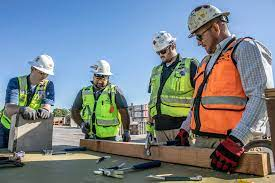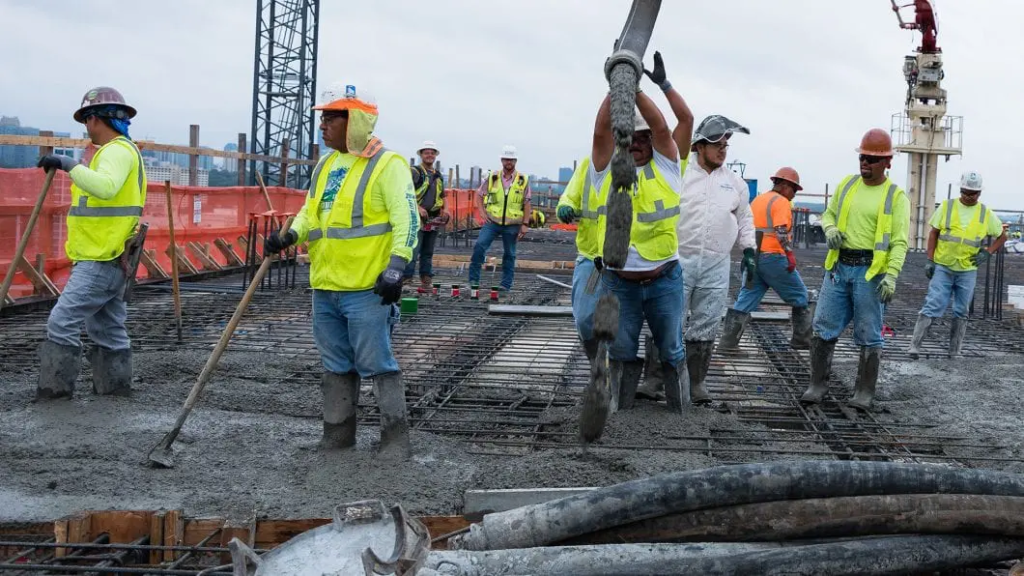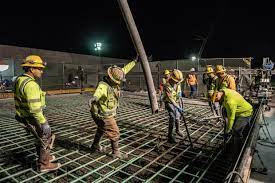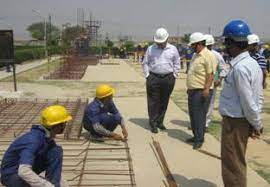Foreman – Concrete ( 6 month course)
Foreman – Concrete click here
Brief Job Description
The job role is responsible for reading and interpreting drawings, standards and specifications, ensuring
completion of preparatory work prior to concreting and directing and monitoring the execution of
concreting works. The job holder also plans, arranges and manages resources and work efficiently in a
team ensuring safe practices are adhered to by the team members.

Personal Attributes
The Foreman – Concrete is expected to be physically fit to work across various locations with varied
environmental conditions. The person should be organized, diligent, methodical, safety-conscious, and a
prompt decision-maker. In addition to being a team player, the individual should have good
communication skills.
Interpret working drawings, specification and standards for concreting works
Description
This unit describes the skills and knowledge required to read and interpret working drawings, specification and standards for concreting works
Scope
The scope covers the following :
Interpret working drawings, specification and standards for concreting works
Elements and Performance Criteria
Interpret working drawings, specification and standards for concreting works
To be competent, the user/individual on the job must be able to:
PC1. interpret details like location, concrete grade, pour area, pouring volume and reinforcement
detail from relevant working drawings for concreting works
PC2. interpret specification provided in the relevant drawing for concreting works
PC3. interpret schedule for concreting works
PC4. interpret the operational standards /manufacturer’s specification of all relevant concreting
tools and equipment
PC5. interpret the method statement for concreting works
PC6. interpret standard technical specification within scope of work
PC7. reproduce technical drawings as simplified hand sketches for explaining and providing clear
instructions to subordinates
PC8. carry out calculation for required quantity of material from structural drawing for reconciliation
and records
Knowledge and Understanding (KU)
The individual on the job needs to know and understand:
KU1. standard practices for concreting works
KU2. safety rules and regulations for handling and storing relevant tools, equipment, and
materials required for relevant works in accordance with organizational norms
KU3. importance of personal protection including the use of related safety gears and equipment in
accordance with organizational norms
KU4. service request procedures for tools, materials and equipment as per organizational norms
KU5. procedure for maintenance of tools and equipment
KU6. principles involved in reading and interpreting various relevant drawings
KU7. how to read general arrangement drawing
KU8. simplified sketch preparation from the drawing
KU9. how to read plan, elevation and sectional drawing
KU10. manufacturer’s specification/ instructions for various concreting tools and equipment
KU11. components, materials and tools used in concreting
KU12. terminology used in concreting

KU13. basic computer literacy
KU14. method statement for concrete works
KU15. calculation for required quantity of material from structural drawing
KU16. all aspects of concreting work (including pouring, screening, leveling and finishing)
KU17. methodology of concreting works
KU18. different mix proportions for concrete
KU19. knowledge of cover to reinforcement with respect to size of reinforcement
KU20. knowledge of construction and expansion joints
Generic Skills (GS)
User/individual on the job needs to know how to:
GS1. write in at least one language, preferably in the local language of the site
GS2. read sketches, instructions provided for the work, and various signboards, safety rules,
safety tags, exit route information in one or more languages, preferably in the local language
of the site
GS3. speak in one or more language, preferably one of the local language at the site
GS4. communicate orally and effectively with team members
GS5. analyze the safety aspect of the workplace
GS6. plan work and organize required resource effectively
GS7. complete work as per agreed time schedule and quality parameters
GS8. resolve any conflict within the teammates
GS9. evaluate the complexity of the tasks
GS10. identify any violation of safety norms during the work
Ensure completion of preparatory works prior to concreting
Description
This unit describes the skills and knowledge required to check and ensure the completion of preparatory
works prior to concreting
Scope
The scope covers the following :
Ensure completion of preparatory works prior to concreting at construction site/yard
Elements and Performance Criteria
Ensure completion of preparatory works prior to concreting at construction site/yard
To be competent, the user/individual on the job must be able to:
PC1. prepare a detailed work plan for execution of concreting work at construction site/yard
PC2. ensure setting out for concreting work is as per the approved drawings
PC3. ensure working platforms, hand rails and access stairs are safe for working
PC4. ensure workplace is clear of debris and guard rails, safety nets and kerb boards are in place
PC5. ensure that the concrete mix is prepared in the specified proportions, within the specified
workability, in case of manual mixing of concrete
PC6. check the grade of concrete prior to concreting

PC7. inspect the required formwork/molds for gaps/misalignment of reinforcement/cover
PC8. check the formwork/molds for leaks during concreting
PC9. ensure cleaning of formwork prior to concreting
PC10. inspect the shoring and bracing of concrete forms to ensure their stability during pour
PC11. indicate route and position for pouring of concrete
PC12. inspect the fixing and setting of pump line and machinery for pouring of concrete
PC13. ensure the use of suitable type of pump as per the discharge and head of concrete
PC14. record details of the concreting works covering grade of concrete, area and volume of pour,
number of workers ,tools and equipment deployed for work and achieved productivity
PC15. oversee and inspect the pumping of concrete
Knowledge and Understanding (KU)
The individual on the job needs to know and understand:
KU1. standard practices for concreting works
KU2. safety rules and regulations for handling and storing relevant tools, equipment, and
materials required for relevant works in accordance with organizational norms
KU3. importance of personal protection including the use of related safety gears and equipment in
accordance with organizational norms
KU4. service request procedures for tools, materials and equipment as per organizational norms
KU5. procedure for maintenance of tools and equipment
KU6. structural drawings relevant to concreting works
KU7. basic principles of measurement along with simple geometry
KU8. methodology for estimation of required resource and material
KU9. standard tolerance levels for concreting work
KU10. difference and comparison between pre-cast and in-situ concreting works
KU11. appropriate proportions for the mixing of concrete to ensure consistency
KU12. appropriate techniques (including use of tools, equipment and material) for all aspects of
concreting work (including pouring, screening, leveling and finishing)
KU13. methodology for checking line ,level and alignment for various concreting works
KU14. methodology of concreting works
KU15. different mix proportions for concrete
KU16. knowledge of cover to reinforcement with respect to size of reinforcement
KU17. knowledge of different type of vibrators, their influence area and use
KU18. knowledge of construction and expansion joints
KU19. how to inspect shoring and bracing of concrete forms
KU20. fixing of pump line for concrete flow
KU21. different type on concrete pumps with respect to head and flow of concrete
KU22. basic computer literacy
KU23. preventive and corrective action to ensure the completion of preparatory works prior to
concreting
KU24. use of laser level
Generic Skills (GS)
User/individual on the job needs to know how to:
GS1. write in at least one language, preferably in the local language of the site
GS2. read sketches, instructions provided for the work, and various signboards, safety rules,
safety tags, exit route information in one or more languages, preferably in the local language
of the site
GS3. speak in one or more language, preferably one of the local language at the site
GS4. communicate orally and effectively with team members
GS5. analyze the safety aspect of the workplace
GS6. plan work and organize required resource effectively
GS7. complete work as per agreed time schedule and quality parameters
GS8. resolve any conflict within the teammates
GS9. evaluate the complexity of the tasks
GS10. identify any violation of safety norms during the work
Direct and monitor the execution of concreting works as per specifications and standard practices
Description
This unit describes the skills and knowledge required to direct and monitor the execution of concreting
works as per the specifications and standard practices and perform checks and corrective actions as per
requirement.

Scope
The scope covers the following :
Ensure execution of concreting in formwork/precast molds and form finished structures
Ensure execution of concreting in extreme hot/cold weather
Examine concrete after stripping forms and instruct repairing of concrete as per applicability
Elements and Performance Criteria
Ensure execution of concreting in formwork/precast molds and form finished structures
To be competent, the user/individual on the job must be able to:
PC1. visually assess the workability and usability of concrete mix and discard detrimental concrete
mix
PC2. prescribe method for pouring, levelling and finishing of concrete as per standard practices
and specifications
PC3. ensure the pouring of concrete from specified height and use of correct type of vibrator for
compaction
PC4. inspect and assist in using tools and equipment relevant to task
PC5. ensure that concrete is compacted to desired consistency and surface is finished to specified
uniformity and smoothness/finish
PC6. ensure leveling of edges and corners within tolerance levels
PC7. direct and monitor the grooving/cutting for expansion/contraction joints
PC8. ensure that the appropriate technique for finishing of concrete works like broom finish, float
and trowel finish etc. has been employed as per drawing
PC9. ensure synchronization of all above concreting activities to ensure rapid placement and
compaction of concrete with respect to the setting time of concrete in case of form finished
structure
PC10. prescribe methods and monitor curing of concrete
PC11. highlight errors to workers, suggest remedial action and demonstrate correct work processes
as per applicability
Ensure execution of concreting in extreme hot/cold weather
To be competent, the user/individual on the job must be able to:
PC12. monitor wind, air, concrete temperature and humidity
PC13. manage schedule of concreting in accordance with the temperature change in day and night
as per hot/cold weather concreting
PC14. provide sunshades/windbreaks/heated enclosures as per the concreting requirement
PC15. check that evaporative retarder/anti-freeze is used in hot/cold weather concreting
PC16. ensure correct preventive measures are taken as per the hot/cold weather concreting
PC17. ensure rapid placement and compaction of concrete as per concreting requirement
PC18. monitor the placing and grooving/cutting of expansion/construction joint as per concreting
requirement
PC19. monitor the curing of concrete for a specified period of time in hot/cold weather concreting
Examine concrete after stripping forms and instruct repairing of concrete as per applicability
To be competent, the user/individual on the job must be able to:
PC20. examine the concrete after stripping of forms for surface deformities and defects
PC21. direct the removal and repair of concrete with porosity, honey comb, or segregated
materials, as approved by senior/client and prescribe method for repair
PC22. ensure proper curing of repaired concrete

Knowledge and Understanding (KU)
The individual on the job needs to know and understand:
KU1. standard practices for concreting works
KU2. safety rules and regulations for handling and storing relevant tools, equipment, and
materials required for relevant works in accordance with organizational norms
KU3. importance of personal protection including the use of related safety gears and equipment in
accordance with organizational norms
KU4. service request procedures for tools, materials and equipment as per organizational norms
KU5. procedure for maintenance of tools and equipment
KU6. structural drawings relevant to concreting works
KU7. basic principles of measurement along with simple geometry
KU8. methodology for estimation of required resource and material
KU9. standard tolerance levels for concreting work
KU10. difference and comparison between pre-cast and in-situ concreting works
KU11. basic properties and mix proportions of concrete
KU12. appropriate proportions for the mixing of concrete to ensure consistency
KU13. appropriate techniques (including use of tools, equipment and material) for all aspects of
concreting work (including pouring, screening, leveling and finishing)
KU14. methodology for checking line ,level and alignment for various concreting works
KU15. methodology of concreting works in horizontal, vertical and inclined surfaces
KU16. different type of high quality concrete finish
KU17. sequence of pour
KU18. variation of slump w.r.t rate of pour
KU19. different type of vibrators used(internal/external vibrators),their accessibility and influence
area
KU20. vibration in congested areas
KU21. construction joints/cold joints
KU22. curing technique of form finished concrete, repaired concrete and hot/cold weather concrete
KU23. self-compacting concrete
KU24. initial, final setting of concrete and their checking
KU25. correct positioning of the pump hose when pumping of the SCC(self-compacting concrete)
KU26. methodology for hot/cold weather concreting works
KU27. major risks associated with hot and cold weather concrete pouring
KU28. knowledge of wind breaks, wind velocity
KU29. different type and use of evaporative retarder/anti-freeze compound
KU30. type of defects in concrete
KU31. different method of repair of concrete
KU32. different type of concrete mixer machines
KU33. how to protect the concreted area from damage
KU34. use of laser level
KU35. basic computer literacy
KU36. preventive and corrective action to ensure that the concreting work meets the quality
requirements
Generic Skills (GS)
User/individual on the job needs to know how to:
GS1. write in at least one language, preferably in the local language of the site
GS2. read sketches, instructions provided for the work, and various signboards, safety rules,
safety tags, exit route information in one or more languages, preferably in the local language
of the site
GS3. speak in one or more language, preferably one of the local language at the site
GS4. communicate orally and effectively with team members
GS5. analyze the safety aspect of the workplace
GS6. plan work and organize required resource effectively
GS7. complete work as per agreed time schedule and quality parameters
GS8. resolve any conflict within the teammates
GS9. evaluate the complexity of the tasks
GS10. identify any violation of safety norms during the work
Plan, arrange and manage resources for execution of relevant work
Description
This unit describes the knowledge and the skills required for an individual to plan and organize work in
order to meet expected outcome.
Scope
The scope covers the following :
Plan and prepare for work
Arrange and manage manpower
Arrange allocate and manage tools, material and equipment for completion of work, as per the plan
Elements and Performance Criteria
Plan and prepare for work

To be competent, the user/individual on the job must be able to:
PC1. identify the targets and timelines for the work set by superiors
PC2. determine the work requirements corresponding to
task(drawings/schedules/instructions/methodology), safety, tools and equipment prior to
commencement of task
PC3. plan the work by analyzing the required outcomes, work procedures, allotted time, resource
availability and known priorities
PC4. prepare the work areas in coordination with team members
PC5. plan for waste collection and disposal prior to and after completion of work
Arrange and manage manpower
To be competent, the user/individual on the job must be able to:
PC6. determine quantum and nature of work under assigned activity
PC7. calculate requirement of manpower for assigned activities
PC8. submit manpower requirement to superiors
PC9. allocate and extract work as per plan
PC10. provide clear instructions to workmen for execution of work
PC11. ensure optimum utilization of manpower resources
PC12. record the daily labor attendance and their daily productivity
Arrange allocate and manage tools, material and equipment for completion of work, as per the plan
To be competent, the user/individual on the job must be able to:
PC13. estimate requirement for material, components, fixtures, equipment, tools and accessories
PC14. submit material, equipment and tool requirement to superiors
PC15. allocate material, equipment and tools to workmen and extract the work as per plan
PC16. provide clear instructions for optimium use of resources
PC17. ensure the work processes adopted are in line with the specified standards and instructions
PC18. complete the work with the allocated resources within specified time
Knowledge and Understanding (KU)
The individual on the job needs to know and understand:
KU1. standard practices for execution of relevant work
KU2. safety rules and regulations for handling and storing relevant tools, equipment, and
materials required for relevant works in accordance with organizational norms
KU3. importance of personal protection including the use of related safety gears and equipment in
accordance with organizational norms
KU4. service request procedures for tools, materials and equipment as per organizational norms
KU5. procedure for maintenance of tools and equipment
KU6. how to identify work activities that need to be planned and organized
KU7. how to undertake all aspect of planning and organizing the task, including interpretation of
task, reading drawing/schedules, arranging resources, reporting problems etc.
KU8. manpower requirement on the basis of quantum of work and productivity
KU9. sequence and priority of activities
KU10. how to identify priority and critical activity of relevant task
KU11. method and technique on briefing team members about relevant work
KU12. different checks to evaluate progress and quality of relevant works
KU13. importance of daily productivity report
KU14. importance of daily attendance register
KU15. how to calculate quantum of relevant work
KU16. calculation of tools and material requirement
KU17. optimium use of available resources
KU18. computer basics
Generic Skills (GS)
User/individual on the job needs to know how to:
GS1. write in at least one language, preferably in the local language of the site
GS2. read sketches, instructions provided for the work, and various signboards, safety rules,
safety tags, exit route information in one or more languages, preferably in the local language
of the site
GS3. speak in one or more language, preferably one of the local language at the site
GS4. communicate orally and effectively with team members
GS5. analyze the safety aspect of the workplace
GS6. plan work and organize required resource effectively
GS7. complete work as per agreed time schedule and quality parameters
GS8. resolve any conflict within the teammates
GS9. evaluate the complexity of the tasks
GS10. identify any violation of safety norms during the work
Work effectively in a team to deliver desired results at the workplace
Description
This unit describes the skills and knowledge required to work effectively within a team to achieve the
desired results

Scope
The scope covers the following :
Interact and communicate in an effective manner
Support co-workers to execute the project requirements
Practice inclusion
Elements and Performance Criteria
Interact and communicate in an effective manner
To be competent, the user/individual on the job must be able to:
PC1. pass on work related information/ requirement clearly to the team members
PC2. inform co-workers and superiors about any kind of deviations from work
PC3. report any unresolved problem to the supervisor immediately
PC4. obtain instructions from superiors and respond on the same
PC5. communicate to team members/subordinates for appropriate work technique and method
PC6. seek clarification and advice as per the requirement
Support co-workers to execute the project requirements
To be competent, the user/individual on the job must be able to:
PC7. hand over the required material, tools, tackles, equipment and work fronts timely to
interfacing teams
PC8. work together with co-workers in a synchronized manner
Practice inclusion
To be competent, the user/individual on the job must be able to:
PC9. maintain cultural inclusivity at work place
PC10. maintain disability friendly work practices
PC11. follow gender neutral practices at workplace
PC12. address discriminatory and offensive behavior in a professional manner as per
organizational policy
Knowledge and Understanding (KU)
The individual on the job needs to know and understand:
KU1. own roles and responsibilities
KU2. importance of effective communication
KU3. the consequence of poor teamwork on project outcomes, timelines, safety at the
construction site, etc.
KU4. different modes of communication used at workplace
KU5. importance of creating healthy and cooperative work environment among the gangs of
workers
KU6. different activities within the work area where interaction with other workers is required
KU7. applicable techniques of work, properties of materials used, tools and tackles used, safety
standards that co-workers might need as per the requirement
KU8. importance of proper and effective communication and the expected adverse effects in case
of failure relating to quality, timeliness, safety, risks at the construction project site
KU9. importance and need of supporting co-workers facing problems for the smooth functioning of
work
KU10. the fundamental concept of gender equality
KU11. how to recognize and be sensitive to issues of disability, culture and gender
KU12. legislation, policies, and procedures relating to gender sensitivity and cultural diversity
including their impact on the area of operation
Generic Skills (GS)
User/individual on the job needs to know how to:
GS1. write in at least one language, preferably in the local language of the site
GS2. read the communication regarding work completion, materials used, tools and tackles used,
the resource required, etc.,
GS3. speak in one or more languages, preferably in one of the local language of the site
GS4. listen and follow instructions / communication shared by superiors/ co-workers regarding
team requirements or interfaces during work processes
GS5. communicate orally and effectively with co-workers considering their educational and social
background
GS6. decide on what information is to be shared with co-workers within the team or to the
interfacing gang of workers
GS7. plan work and organize the required resources in coordination with team members
GS8. complete all assigned task in coordination with team members
GS9. take initiative in resolving issues among co-workers or report the same to superiors
GS10. ensure best ways of coordination among team members
GS11. evaluate the complexity of task and determine if any guidance is required from superiors
Supervise, monitor and evaluate performance of subordinates at workplace
Description
This unit covers the skills and knowledge required by an individual to supervise,monitor and evaluate
performance of subordinates at the work place
Scope
The scope covers the following :
Monitor and evaluate subordinates performance as per quality standards and timelines
Practice and promote gender inclusive behavior and leadership
Elements and Performance Criteria
Monitor and evaluate subordinates performance as per quality standards and timelines
To be competent, the user/individual on the job must be able to:
PC1. fix expected targets for the respective gang as per site requirements and allocate work to
subordinates
PC2. establish expected performance standards and expectations for the respective gang of
workers to meet the desired outcomes
PC3. inspect assigned work to the respected gang of workers through progressive checking
PC4. observe and verify the work activities performed by the subordinates at the construction site
PC5. monitor overall performance of subordinates on the designed measures to ensure quality
requirements set by the concerned authority
PC6. ensure adherence to the organizational policies and procedures for all relevant construction
activities by the workmen subordinations
Practice and promote gender inclusive behavior and leadership
To be competent, the user/individual on the job must be able to:
PC7. promote a safe, supportive, inclusive and gender sensitive environment at workplace.
PC8. manage and facilitate capacity building to enable inclusion of all genders
PC9. take prompt corrective action in case of inappropriate behavior at workplace
Knowledge and Understanding (KU)
The individual on the job needs to know and understand:
KU1. policies, procedures and work targets for performance evaluation and appraisals
KU2. organizational policies, procedures and protocol for smooth completion of work at the
respective workplace
KU3. complete work/task accurately by following standard specifications and procedures by
optimized and correct used of materials , tools, tackles and equipment
Generic Skills (GS)
User/individual on the job needs to know how to:
GS1. write in at one or more language, preferably the local language
GS2. read in at one or more language, preferably the local language at the site
GS3. speak in at one or more language, preferably one of the local language at the site
GS4. communicate effectively with team members at workplace
GS5. plan work as per right sequence and organize required resources in coordination with the
team members
GS6. complete work as per the requirement
GS7. evaluate and find solutions to minimize errors and suggest improvements for optimizing
resource utilization
GS8. assess which situations would require intervention of superiors
Manage workplace for safe and healthy work environment
Description
This unit describes the skill and knowledge required to maintain a healthy & safe working environment for the group of people working under an individual
Scope
The scope covers the following :
Ensure effective implementation of health, safety and environment policies and procedures
Identify and respond to risks / fire and emergencies associated with the work practices and
workplace
Ensure sanitization and infection control guidelines are followed at construction site
Elements and Performance Criteria
Ensure effective implementation of health, safety and environment policies and procedures
To be competent, the user/individual on the job must be able to:
PC1. implement safe handling and stacking methods at workplace /store
PC2. ensure the adequate availability and placing of safety and protection installations at site
PC3. ensure that safe access ways are available at work place for movement of workers and
materials
PC4. ensure the safe use of tools and tackles by teammates as per work requirements
PC5. ensure ergonomic principles are adopted by the teammates while lifting and shifting of
construction materials, tools and equipment
PC6. ensure appropriate use of following Personal Protective Equipment (PPE) as per work
requirement of head protection, ear protection, fall protection, foot protection, face and eye
protection, hand and body protection, respiratory protection
PC7. maintain entry and exit pathways from confined spaces, excavated pits and other location as
per safety parameters/instructions
PC8. ensure proper housekeeping at workplace
PC9. ensure that subordinates adhere to health and safety plans
Identify and respond to risks / fire and emergencies associated with the work practices and workplace
To be competent, the user/individual on the job must be able to:
PC10. identify any hazard at workplace and report/notify the same to appropriate authorities.
PC11. follow procedures for accident recording and reporting as per organizational and statuary
requirements
PC12. ensure effective adherence to emergency response procedures / protocols
PC13. select and operate different types of fire extinguishers corresponding to types of fires as per
EHS guideline
PC14. obtain ‘height pass’ clearance as per EHS guideline
PC15. implement control measures to reduce risks ,meeting legislative requirements within the
scope of own role and expertise, as per organizational policies
Ensure sanitization and infection control guidelines are followed at construction site
To be competent, the user/individual on the job must be able to:
PC16. promote awareness about latest hygiene and sanitation regulations
PC17. ensure disinfection procedure related to material, tools and supplies are followed properly
PC18. respond to infection prevention and control and its non-compliance , within scope of own role
or report to required personnel
Knowledge and Understanding (KU)
The individual on the job needs to know and understand:
KU1. the policies, procedures and protocol set up by the EHS Department with respect to Health ,
Safety and Environment at the respective construction site
KU2. reporting procedures in cases of breaches or hazards in site safety, accidents or emergency
situations
KU3. safe working practices for tools, tackles and equipment
KU4. workplace policies and health and safety requirements for dealing with potential risks as
defined by the EHS department
KU5. how to respond to accidents and emergencies
KU6. the appropriate personal protective equipment to be used based on various working
conditions
KU7. how to use necessary material ,tools, tackles and equipment in a safe and appropriate
manner as specified by site EHS for each level and respective workman gang
KU8. ways of transmission of infection
KU9. ways to manage infectious risks at the workplace
KU10. different methods of cleaning, disinfection, sterilization and sanitization
KU11. symptoms of infection like fever, cough, redness, swelling and inflammation
KU12. actions be taken during a medical emergency
KU13. current guidelines, national legislation, local policies and protocols regarding spread of
infectious disease.
Generic Skills (GS)
User/individual on the job needs to know how to:
GS1. write in at least one language, preferably in the local language of the site
GS2. read instructions provided for the work, and various signboards, safety rules, safety tags, exit
route information in one or more languages, preferably in the local language of the site
GS3. speak in one or more language, preferably one of the local language at the site
GS4. listen and follow instructions shared by site EHS and superiors regarding site safety
GS5. communicate reporting of site conditions, hazards, accidents, etc.
GS6. analyze the safety aspect of the workplace







